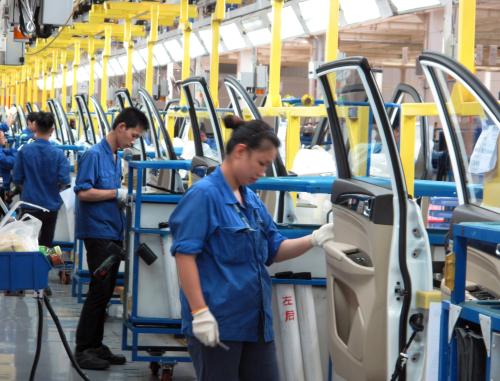Mireya Solís explains current global trade dynamics in Asia-Pacific and what they mean for the incoming Biden administration. This piece was originally written for the Japan Center for Economic Research and the Nikkei, a version of which appeared in Japanese in the Nikkei’s Global Opinion column.
A region in flux: tariff wars, tech decoupling, and mega trade agreements
On October 4, 2015, twelve countries announced the conclusion of the original Trans-Pacific Partnership (TPP) negotiations. It represented the high noon of a U.S.-led vision for regional integration, a deepening of U.S.-Japan cooperation to advance a shared agenda for high-quality economic standards among a diverse set of countries in the region, and a bet on a rules-based approach to the China challenge. On the latter, the delivery was two pronged: putting pressure on China to reform its market-distorting policies and ensuring that the United States remained central to the construction of the regional economic architecture.
The original TPP project never materialized. In its stead, the region was transformed by new geopolitical realities. The United States turned inward, its trade diplomacy hobbled by a decades-long inability to adopt domestic measures to facilitate social adjustment to economic change. China doubled down on an interventionist industrial policy to achieve dominance and greater self-sufficiency in the industries of the future. Both superpowers partook in a costly trade war and reached a modest truce in a stage one bilateral trade deal. Restrictions on tech flows have proliferated with tighter American export controls and sanctions on Chinese telecom firms; and China’s recent export control law heralds retaliation in kind. Wholescale decoupling is unlikely to manifest as foreign firms do not want to lose the vast Chinese market, but in key sectors like semiconductors separate manufacturing ecosystems appear closer.
Asia is both a battleground for U.S.-China strategic competition and a cradle for two recent mega trade deals that aim to sustain bonds of economic interdependence. While there are many differences between the TPP’s successor, the Comprehensive and Progressive Trans-Pacific Partnership (CPTPP), and the Regional Comprehensive Economic Partnership (RCEP), they have a common genesis: middle power diplomacy. As the largest remaining economy after the U.S. exit from the deal, Japan was a pivotal player in ensuring the TPP project survived with its commitments to ambitious tariff liberalization and the suspension of a few provisions mostly on intellectual property.
RCEP’s signature on November 15, 2020 marked a major step in consolidating intra-regional integration. Once it enters into force, the fifteen-member trade grouping will be the largest in the world with a 30% share of global GDP and total population. Undoubtedly, RCEP suffered a blow with India’s decision to step out last year as negotiations were nearing completion out of concern over its trade deficit with China. However, RCEP members have left the door open to India for an immediate return and will entertain accession bids from other parties eighteen months after the deal enters into force.
RCEP’s promise lies in its ability to nurture global supply chains at a time when they face growing strains from trade and tech restrictions as well as greater appetite among some governments to encourage onshoring of production as a response to the COVID-19 pandemic. It is the combination of tariff reductions, lenient rules of origin, and foreign direct investment (FDI) and services liberalization that will provide a boost to regional production networks. Overall tariff elimination at around 92% (to be achieved in the next twenty years) is above the World Trade Organization’s threshold for regional trade agreements, but does leave ample room to keep sensitive products protected. RCEP members did not adopt a common approach to tariff schedules, meaning some countries will have a single tariff applied to all parties, while others will operate with bilateral tariff schedules. The effects of tariff liberalization will be felt most dramatically for those countries that do not have preferential trade terms amongst them. For example, Japan’s share of duty-free exports to China will increase from 8% to 86%, and to South Korea from 19% to 92%.
All RCEP members will benefit from operating with a common set of disciplines and from rules of origin that are designed to deepen the intra-regional division of labor. Rules of origin establishing which products can enjoy the tariff preferences are flexible in RCEP, requiring for instance only 40% of regional content value and a single customs certificate. It should not be onerous for companies in the fifteen member countries to source from within the bloc to enjoy the tariff preferences. Further assisting the development of supply chains are provisions liberalizing FDI by eliminating performance requirements and outlawing forced technology transfers. On investor-state dispute settlement, RCEP members punted the issue by agreeing to revisit it two years after enactment. Akin to the tariff schedules, there is no uniform approach on services liberalization: Some members will operate with a negative list, while others will operate with a positive list with the goal of transitioning over time to the negative list approach. RCEP’s gains from trade are projected to be large by economists Peter Petri and Michael Plummer, adding $186 billion to the world economy by 2030. The largest beneficiaries are China ($85 billion), Japan ($48 billion), South Korea ($23 billion), and ASEAN nations ($17 billion).
RCEP is a signal achievement for ASEAN diplomacy ushering in a trade agreement that retains the organization’s centrality, adopts flexibility in its commitments to reflect the gaps in development levels, and creates a secretariat to advance liberalization efforts in the future. At the same time, China did not need to lead the negotiations to obtain windfall benefits. RCEP blunts the narrative of decoupling as China finds itself a member to the world’s largest trade grouping. To the extent that China outpaces others in its recovery from the economic turmoil caused by the 2020 pandemic, its pull in regional integration will grow. Beijing did not have to sacrifice key levers of its industrial policy to reap the economic and geopolitical benefits of RCEP membership. The agreement has no chapters on state-owned enterprises and industrial subsidies. Even China’s much-vaunted acceptance of commitments on free data flows can be easily subverted given that there is a broad self-judging national security exemption attached. China’s digital protectionism and its state capitalism model remain untouched.
Likely encouraged by these positive developments, China is now signaling stronger interest in joining the CPTPP. President Xi Jinping alluded to this possibility in the last APEC summit meeting. China’s accession remains a distant prospect given Beijing’s reluctance to abide by the agreement’s stricter standards. Granting China wide exemptions from the CPTPP’s disciplines is unlikely to garner consensus among existing members, nor are China’s recent economic coercion measures against Australia creating a conducive climate for an accession bid. Regardless of China’s rhetoric on CPTPP, a profound reality is unmistakable: The engines of regional integration—embodied in the Asian mega trade deals—are moving forward, leaving behind the United States.
Leading in Asia amidst domestic constraints: Charting a course for the Biden administration
Joe Biden will assume the presidency on January 20, 2021 at a time of profound crisis for the United States. Bringing the COVID-19 pandemic under control and preventing a deeper economic recession while providing a safety net for a vast number of suffering Americans will be the most immediate tasks at hand. Despite Biden’s calls for greater unity, the assault on electoral integrity by outgoing President Donald Trump does not bode well for the future. At the time of this writing, the control of the Senate remains undecided with important implications for the ability of the Biden administration to move its legislative agenda and to secure budgetary allocations to resource domestic and international policy priorities. On the external front, friends and foes will look for early cues on the parameters and execution of Biden’s foreign policy: How will the new administration frame competition with China? How will it deliver on its goals of bringing America back as a champion of multilateralism, a committed ally, and a global player in tackling climate change and pandemic recovery?
When it comes to trade diplomacy in the Indo-Pacific, the Biden administration confronts hard questions: How should the administration handle the legacy of “America First” foreign policy? How can it create a consensus within a diverse Democratic camp that can also secure allies across the aisle and cultivate the support of numerous stakeholders? How can it rebuild American credibility in the region to instill confidence in allies and partners that the United States can play a constructive role in shaping the regional architecture and deliver on negotiated commitments?
The Trump presidency leaves behind a legacy of unilateral tariffs, narrow executive trade agreements with China and Japan, and a revamped NAFTA (renamed USMCA) that was modernized by incorporating TPP-like provisions in areas like the digital economy, but also adopted far more restrictive rules of origin on automobiles and tighter labor and environmental standards that the Democrats had long supported. The USMCA represents a rarity in U.S. trade politics: a bipartisan vote for ratification, making it an important bellwether for the future of American trade policy.
That future will not include a quick draw down of the $360 billion worth of tariffs on Chinese goods. President-elect Biden has indicated he will use them as leverage to rebalance the economic relationship with China. It is unclear, however, if his administration will opt for negotiating a stage two trade deal that incorporates disciplines to prevent intellectual property theft and reins in Chinese unfair trading practices, or if it will discard altogether a bilateral agreement that Biden sees as deeply flawed. In any case, largescale trade negotiations with China or other countries will have to wait for several reasons. First is the urgency of the recovery agenda and Biden’s pledge to focus first on boosting domestic economic competitiveness. Second is the need to sort out important differences within the Democratic coalition that Tom Wright has aptly described as a divide between “restorationists” and “reformists.” The latter are more skeptical of globalization, believe in hard-edged competition with China, and favor industrial policy and an overhaul of free trade agreements. Third, the process of confirming appointees and staffing agencies takes time. Though, it is encouraging that a seasoned trade hand, Katherine Tai, chief trade counsel of the Ways and Means Committee, has been tapped for next USTR. These are all powerful reasons for a slow start on trade negotiations, but there will be consequences: Trade Promotion Authority (guaranteeing a top-down vote by Congress) will expire in July 2021 and the Indo-Pacific is not waiting for the United States to make a slow comeback.
The Biden team’s “Buy in America, Make in America” brand appeals to a domestic audience but will not restore American leadership in Asia. A priority for the Biden administration’s Asia policy should be to articulate a positive case of U.S. economic engagement that goes beyond shared concerns over China’s mercantilism. In the effort to bring “America Back,” Japan stands out as an indispensable partner. The promise of U.S.-Japan cooperation lies not in doubling down on a narrow bilateral approach, but rather in recapturing the spirit of the original TPP project: the promise of pooling economic heft and shared commitment to high standards to shape an open and inclusive regional architecture. But there is no going back to the original TPP, realities on the ground have changed.
Therefore, the U.S.-Japan partnership must be effective in light of fractious U.S. domestic politics, a more influential China, and the rollout of mega trade deals. In the short term, the United States in collaboration with Japan and other partners can launch three major initiatives: 1.) negotiations for a plurilateral digital agreement that builds from the disciplines of the CPTPP and the U.S.-Japan digital trade agreement; 2.) a supply chain resiliency framework in response to the pandemic that brings transparency to stockpiling efforts, creates diversification and redundancy of suppliers, and maintains open access to essential medical goods; and 3.) an economic security dialogue among like-minded countries to ensure that FDI screening, export controls and cyber laws address security risks without unduly clamping down on innovation and economic exchange.
Down the road, the United States will be better served by seeking admission to the CPTPP rather than launching negotiations of a new regional trade agreement that could take years to conclude. In that effort, the United States could request targeted renegotiations to incorporate USMCA-like provisions on labor and the environment that are important to shore up congressional support. CPTPP members are likely to welcome a U.S. return that would give them preferential access to the large American market and would anchor the U.S. to the region in its role as protector of a rules-based order. Moreover, an accession negotiation eliminates the risk that dysfunctional U.S. politics will bring down an entire trade initiative.
In its role as CPTPP chair in 2021, Japan could help lay down the groundwork to welcome back the United States. It is time to award the U.S.-Japan partnership the true measure of its potential.










Commentary
Is America back? The high politics of trade in the Indo-Pacific
January 4, 2021